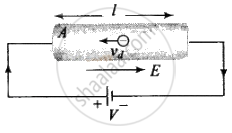Advertisements
Advertisements
Question
Which of the following characteristics of electrons determines the current in a conductor?
Options
Drift velocity alone
Thermal velocity alone
Both drift velocity and thermal velocity
Neither drift nor thermal velocity
Solution
Drift velocity alone
Explanation:
Drift velocity is the average uniform velocity acquired by free electrons inside a metal by the application of an electric field which is responsible for the current through it

The direction of drift velocity for electron in a metal is opposite to that of applied electric field (i.e. current density `vecJ`).
`V_d oo E`, i.e. greater the electric field, larger will be the drift velocity.
The relationship between current and drift speed is given by I = ne Avd
Here, l is the current and vd is this drift velocity.
So, `I oo v_d`
Thus, only drift velocity determines the current in a conductor.
Important point: Remember direction of drift velocity and current is opposite, so we are taking the magnitude of drift velocity or drift speed of free electrons.
APPEARS IN
RELATED QUESTIONS
A steady current flows in a metallic conductor of non-uniform cross-section. Which of these quantities is constant along the conductor: current, current density, electric field, drift speed
One of your friends says that he has read in the previous chapters that there can be no electric field inside a conductor. Consequently, there can be no current through it. What is the fallacy of this argument?
Does a conductor become charged when a current is passed through it?
Answer the following question.
How is the drift velocity in a conductor affected with the rise in temperature?
A hank of uninsulated wire consisting of seven and a half turns is stretched between two nails hammered into a board to which the ends of the wire are fixed. The resistance of the circuit between the nails is determined with the help of electrical measuring instruments. Determine the proportion in which the resistance will change if the wire is unwound so that the ends remain to be fixed to the nails.
A current of 5A is passing through a non-linear magnesium wire of cross-section 0.04m2. At every point, the direction of current density is at an angle of 60° with the unit vector of area of cross-section. The magnitude of electric field at every point of the conductor is ______.
Resistivity of magnesium = 44 × 10-8 Ωm
